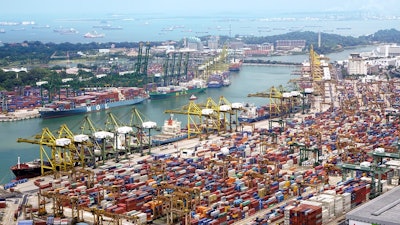
While much of the world has spent the last couple of months sheltering at home to avoid the COVID-19 pandemic, grain trade has continued supplying nations with needed commodities. As many parts of the world are on the verge of reopening, U.S. Grains Council (USGC) President and Chief Executive Officer Ryan LeGrandsat down with the National Association of Farm Broadcasting (NAFB)to discuss how the movement of grain has continued, mostly unhindered, throughout the global spread of the coronavirus.

“现实是粮食的物理运动、铁ed and ethanol hasn't fundamentally changed,” LeGrand said. “Loading the various modes of transportation with grains really doesn't require the presence of a large group of people, so the flow of grain and feed has gone largely uninterrupted during the pandemic.”
LeGrand said that while he expects few changes in the overall processes of fulfilling customer orders, there have been some shifts. For example, many countries are now accepting electronic versions of phytosanitary certificates, which are produced by the U.S. government deeming the product free of pests and other contaminants. Previously, importing countries typically only accepted a hard copy.
“I think the actual trading will look much the same in both the short and long terms,” LeGrand said. “Deals happen over phone calls and emails, and that will remain the same. In the short term, I think we're going to see far fewer industry events where people gather, so that will have an effect on networking, which is an important part of the industry, but how long that lasts really remains to be seen.”
LeGrand says the impact of the pandemic is shifting market development activities, but USGC’s global staff remains committed to the organization’s mission of developing markets, enabling trade and improving lives.
“Throughout USGC, we have shifted to a virtual world,” LeGrand said. “So much of what we've done in our 60 years of existence has involved face-to-face meetings with buyers and with foreign policy makers. In the past maybe a virtual meeting could have been presented as an alternative. Going forward, it could be that the virtual meeting is the first option, and in-person meeting could be considered as an alternative.
"I hope that sooner rather than later, we have the confidence to get on a plane and fly to meetings or conferences, but the reality of our situation doesn't currently allow for that to happen.”
LeGrand emphasized while some of the methods have changed, USGC’s mission of developing markets, enabling trade and improving lives has not. The organization’s global staff have fully embraced technology and continuing to make trade happen, even when face-to-face meetings are not possible.
Learn more about theUSGC's work during the COVID-19 pandemic.
Hear the audio: Council CEO LeGrand Details Grain Market Movements During COVID-19





















